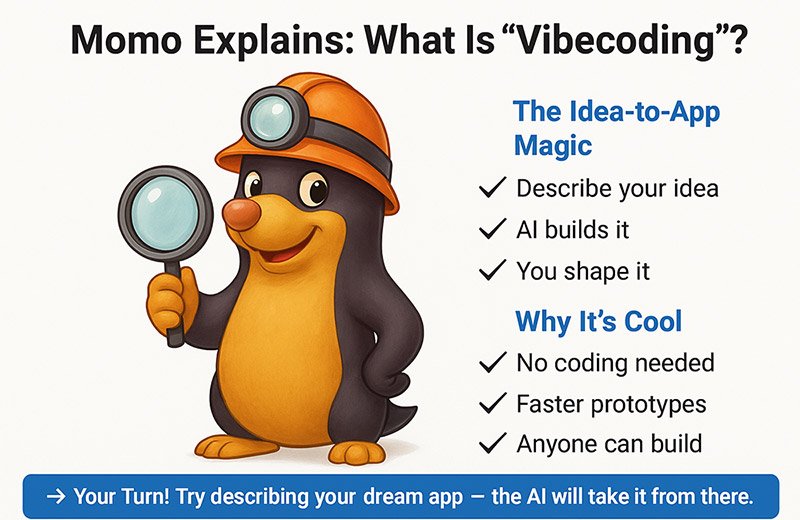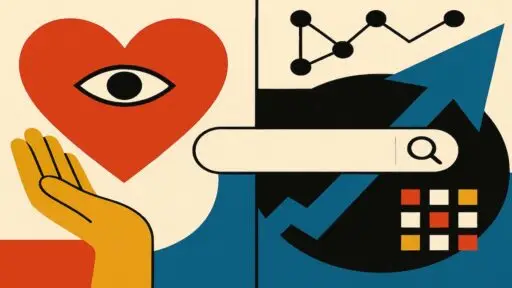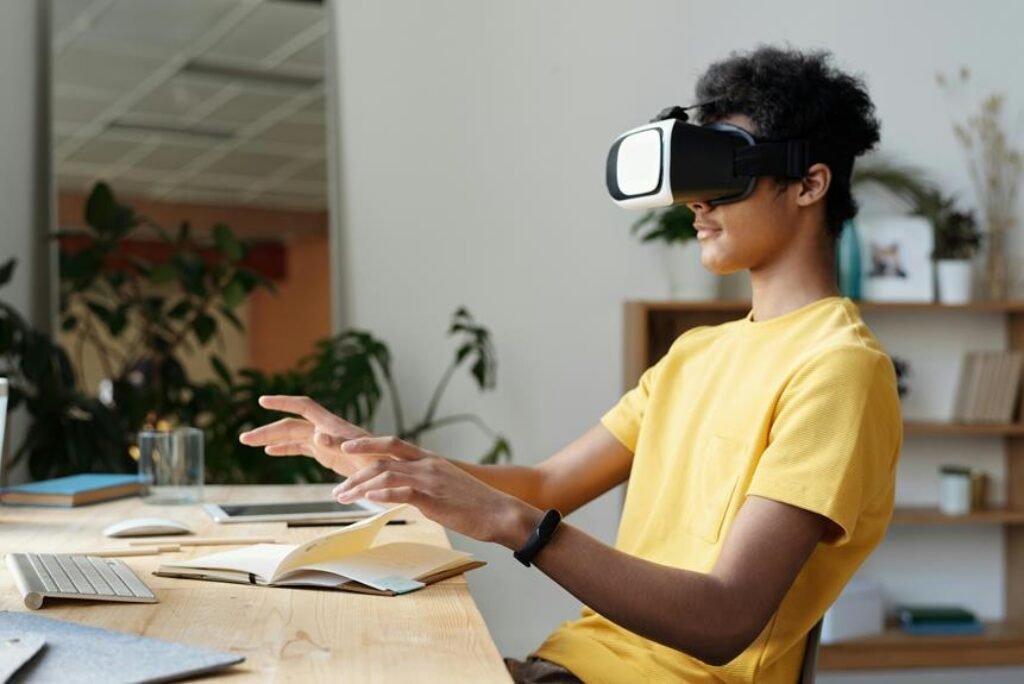Table of Contents
I. Introduction: The Magic Trick of Building Apps
Ever wished you could conjure an app into existence simply by describing it — like ordering a custom pizza with extra anchovies and a side of philosophical pondering? Well, prepare to be amazed.
Enter Vibecoding, a concept as whimsical as its implications are profound. Imagine an AI assistant, a digital muse, capable of translating your app ideas into reality, even if you’ve never wrestled with the intricacies of computer code.
Forget the bewildering cascade of semicolons and brackets. Vibecoding is about capturing the very essence — the vibe — of your idea and letting the AI handle the technical heavy lifting.
If “low-code” and “no-code” tools made app creation accessible, Vibecoding aims to make it intuitive — a natural language conversation between human creativity and machine logic.
In this article, we’ll delve into the heart of Vibecoding, tracing its origins, examining its reception, and venturing into the tantalizing possibilities that lie ahead.
II. Back to the Future: A Quick History Lesson
Old-School Coding:
Picture a world where every command, every nuance of instruction, had to be painstakingly typed like a digital Sisyphus eternally pushing the boulder of syntax uphill. That, my friends, was the realm of traditional coding.
AI’s Helping Hand (Pre-Vibecoding):
Around 2021, AI began to tentatively offer assistance — a subtle nudge in the right direction. Think of it as autocorrect, but for the esoteric language of code: a helpful spirit whispering suggestions through tools like GitHub Copilot and OpenAI’s Codex.
Then came Andrej Karpathy’s audacious declaration in 2023: “English is the hottest new programming language.” A provocative statement, hinting at a future where natural language would become the primary interface for human-computer interaction.
The Birth of Vibecoding (Early 2025):
Karpathy, the intellectual instigator, christened this paradigm shift Vibecoding — a term that encapsulates its intuitive, feeling-driven nature. He envisioned a world where, for rapid prototyping, one could almost “forget that the code even exists.”
The term caught fire beyond tech circles, appearing in design blogs, startup pitches, and eventually Merriam-Webster’s trending list — a cultural wink that signaled something had changed in how we imagine making things digital.
III. So, What Is This “Vibecoding” Thing Anyway?
Let’s make it simple: instead of wrangling lines of code, you tell the AI what you want — almost like describing a dream to someone who can build it.
Your Idea, AI’s Code:
No jargon. No syntax. Just you explaining what you have in mind.
Example for Grandpa:
“Make an app that reminds me to water my heirloom tomatoes — and maybe sends a nice compliment when I do.”
Example for a 5th Grader:
“Create a space game where an alien collects donuts and avoids exploding rocks. Bonus points if the alien can dance.”
You’re the Director, Not the Typist:
Think of yourself as the conductor in front of an invisible orchestra. You tell the AI what kind of melody you want — tone, rhythm, emotion — and it plays the notes. Your job isn’t typing commands; it’s shaping how the whole experience should feel.
It’s a Conversation, Not a Command Line:
Vibecoding isn’t one-sided. You talk, the AI builds, you adjust, it learns.
You might say, “The buttons feel too small,” or “That blue is a little too corporate.” And the AI changes it instantly, no sighing, no all-nighters. It’s collaborative tinkering at its finest.
Tools of the Trade:
Platforms like Replit, Google AI Studio, or OpenAI’s GPT Builder act as creative studios for this back-and-forth. Some even let you sketch, talk, or show examples instead of typing — perfect for visual thinkers who like to build by feel, not formula.
IV. The Good, The Bad, and The “Huh?” What People Think Right Now
The “Wow” Factor:
- It’s Fast.
Vibecoding speeds up development to the point where weekend projects feel doable. You could build something meaningful between Friday night and Sunday brunch. - Anyone Can Play.
You don’t need a computer science degree to bring your idea into the world. That 70-year-old gardener? He can finally automate his tomato reminders. The 10-year-old dreamer? She can bring her donut-collecting alien to life. - It’s Actually Fun.
When the heavy lifting’s done for you, you can focus on the parts that make your imagination tick, like story, design, flow, and purpose. You’re not buried in brackets; you’re shaping an experience. - Teamwork Feels Easier.Writers, designers, and devs can finally “speak the same language.” There’s no translation layer between creativity and code — just conversation.
The “Hmm…” Factor:
- Security Nightmares.
- AI can make mistakes, and a minor bug might open a big door. The infamous “Lovable” app fiasco proved that charm doesn’t equal safety.
- Messy Code Syndrome.
- Some developers joke that AI code looks like a toddler’s art project — bright, chaotic, and somehow still running. It works, but barely.
- Debugging Without a Map.
- If you didn’t write the code, fixing it can feel like poking at a spaceship with a spoon.
- Over-Reliance.
- Veterans worry newcomers won’t bother to learn what’s under the hood. When everything’s generated for you, curiosity can quietly erode.
- Not Quite Ready for the Big Leagues.
- Vibecoding is magic for small ideas — less so for critical, enterprise-scale systems. It’s still a creative playground, not a replacement for engineering rigor.
V. Crystal Ball Gazing: What’s Next for Vibecoding?
More intelligent AI, Better Vibes.
Future AIs will grasp nuance — tone, intent, even emotion — enabling them to capture your app’s “feel,” not just its function.
New Job Titles.
“Coder” will morph into “AI Orchestrator,” “Prompt Architect,” or “Interaction Designer.” The skill will not be typing code, but shaping collaboration.
Multimodal Creation.
Voice prompts, hand-drawn sketches, and gesture-based inputs will also be integrated. Imagine explaining your app aloud while the AI assembles a live prototype on the screen.
Regenerative Code.
Instead of patching bugs, we’ll ask the AI to “rewrite this section cleanly.” Codebases could become living organisms, regenerating when flawed.
Self-Auditing Systems.
Security AIs will police their own creations, spotting loopholes faster than humans can blink.
Integration Nation.
Vibecoding will converge with design tools, AI agents, and cloud deployment systems, forming a seamless “build-to-launch” loop.
A Culture Shift.
Coding will feel less like engineering and more like creative direction, ushering in the next era of digital authorship.

VI. Momo’s Take: The Curious Coder Who Never Coded
Momo the Mole has been watching all this Vibecoding buzz from his burrow, eyes twinkling beneath that trusty headlamp.
He’s never written a line of code — paws aren’t ideal for keyboards — but he understands something more profound: the art of digging for meaning.
When he first heard that people were now “vibing” their way into apps, he tilted his head and smiled.
“So,” he mused, “we’ve finally learned to talk to the machines in our own language with feelings first, code second.”
One afternoon, Momo decided to try it himself.
He asked an AI to help him build a little app called CookWithMomo — a cozy digital kitchen where recipes adapt to your mood.
If you’re tired, it suggests something comforting; if you’re inspired, it encourages experimentation.
All Momo had to do was describe the feeling he wanted users to experience: creativity without pressure, nourishment without perfection.
The AI took care of the rest.
“I didn’t just build an app,” Momo said. “I built a reflection of how I care.”
That’s the essence of Vibecoding: you don’t need to speak the language of machines — you need to describe what matters.
Momo calls it “searching with soul.”
VII. Conclusion: The Human Touch in an AI World
Vibecoding represents a cultural turning point — a bridge between imagination and implementation.
Rather than eliminating coding, it reframes it. The question shifts from “Can I build this?” to “What do I want to create?”
Like any power tool, it demands wisdom, curiosity, and restraint. The future isn’t about machines replacing us, but about machines listening more effectively to human creativity.
So, go ahead: converse with your AI, describe your vision, and shape the digital landscape with your voice and intuition.
The code may disappear from view, but your imagination is now the compiler.z







